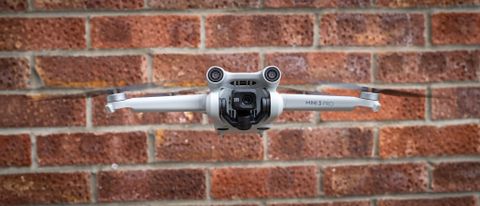Space Verdict
With some seriously impressive features aimed at enthusiasts and professional drone pilots alike, the tiny 249g DJI Mini 3 Pro is a highly capable and portable drone.
Pros
- +
Popular sub 250g category
- +
Excellent image quality
- +
Offers obstacle avoidance
Cons
- -
More expensive than previous Mavic Mini models
- -
Not as fully featured as the Mavic 3
Why you can trust Space.com
Weight: 8.78oz / 249g
Dimensions: Folded 145x90x62mm / Unfolded 171x245x62mm
Battery: Standard battery – 2453 mAh Li-ion / up to 31 minutes
Plus battery – 3850 mAh Li-ion / up to 47 minutes
Charger type: AC Mains DJI 30W USB-C hub (available separately) / USB-C cable
Modes: Cine, Normal, Sport
Video transmission range: up to 7.5 miles / 12km
Video resolution: 4K, 2.7K, 1080p (FHD)
Frame rates: 4K up to 60fps / 2.7K up to 60fps / FHD up to 120fps
They say good things come in small packages, and with the DJI Mini 3 Pro you get a tiny and lightweight drone that’s bursting with features. For our money, it’s the best DJI Mavic Mini series drone to date. Released on 10 May 2022, The Mini 3 addresses the shortcomings of previous models to provide a sub 250g category drone that’s equally suited to both enthusiasts and professionals.
This latest incarnation of DJI’s smallest and lightest drone features obstacle avoidance for the first time. Not only does this ultimately make the drone safer and easier to fly, but it also brings with it features such as Quickshots which are automated flight patterns for capturing professional-looking video. It also delivers Follow Me functionality where the drone will follow subjects with several options for tracking subjects.
The camera has also experienced an overhaul and now features a 1/1.3-ich 12.1MP sensor that’s larger than the ones used in both the Mavic Mini 2 and Mavic Air 2; a fast f/1.7 provides excellent light gathering capabilities alongside a 24mm equivalent focal length; and with 48MP photos in Raw and JPEG possible, 4K video up to 60fps available in Standard and D-Cinelike profiles, this is a powerful drone that belies its diminutive size. In fact, we’d say it’s one of the best drones on the market right now.
DJI Mini 3 Pro: Design
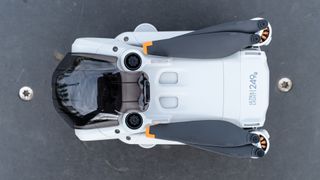
- Tiny, lightweight and highly portable
- Folding design
- Two controller options
As you’d expect from a DJI Mavic model, the Mini 3 Pro features a folding design. This, alongside the 249g weight make it incredibly small and lightweight with a folded size of just 145x90x62mm and an unfolded size of 171x245x62mm. Compared to other Mavic models, it certainly doesn’t feel as solid, but this has no bearing on the overall build quality or flight performance. And the propeller arms have been made more aerodynamic with the propellers being larger than those used by the Mini 2 to help to increase flight times.
The overall look of the drone has changed since the Mavic Mini 2, although it certainly looks like a Mavic. This design tweak is mostly down to the addition of the large obstacle sensors on the front of the airframe, alongside the dual mounted gimbal that supports 90° rotation of the camera for portrait format shooting.
In terms of the controllers available, the standard kit comes with the DJI RC-N1, which is a screen-free model with a telescopic phone holder at the top for attaching a smartphone via a cable that can be stowed within the holder. This will provide the perfect balance of cost versus utility for most people, although those happy to pay more can opt for the kit with the new DJI RC Smart Controller. This features a 5.5-inch touchscreen with a 700-NIT brightness and weighs 390g compared to the DJI RC-N1 Controller which weighs in at 385g, plus the weight of a smartphone.


DJI Mini 3 Pro review: Functionality
- Advanced Pilot Assistance System (APAS) 4.0
- Quickshots and subject tracking
- Increased battery life
Previous Mavic Mini models didn’t feature obstacle avoidance, so the arrival of this useful function thanks to a tri-directional obstacle sensing system with front, rear and downward facing wide-angle sensors is most welcome. Alongside Advanced Pilot Assistance Systems 4.0 (APAS 4.0), this allows you to set collision avoidance to brake when an obstacle is detected, fly around obstacles, or it can be turned off.
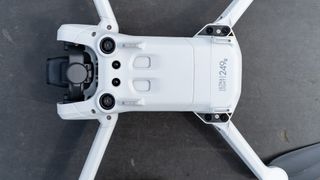
This in turn brings with it additional features that have previously been absent from Mavic Mini drones which include Quickshots and subject tracking/Follow Me. Quickshots are a suite of automated flight patterns to help you to capture professional-looking cinematic video footage. While the FocusTrack Suite offers two options for tracking moving and static subjects autonomously and a third for manual flight while the camera tracks a predefined subject.
These new features, alongside improvements to the camera, have made the Mini 3 Pro a highly capable offering all-round. And despite its small size and low weight, the Mini 3 Pro offers wind resistance of just under 24mph making it usable in a wide range of conditions. Plus, there are the standard Cine, Normal and Sport modes that provide different flight speeds and functionality, with Sport providing the fastest maximum speed of up to 35.7mph.
Battery life has also been improved compared to previous models thanks to the new 2453mAh Intelligent Flight Battery that’s advertised to provide up to 34 minutes of flight time. In real world flights, this is closer to 20-25 minutes depending on conditions. There is also an Intelligent Flight Battery Plus featuring a 3850mAh capacity and an advertised flight time of up to 47 minutes. This is available in some regions including the United States and Australia, but not in others such as the European Union.
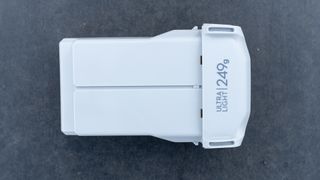
DJI Mini 3 Pro: Performance
- 12.1MP 1/1.3-inch sensor
- Up to 4K 60fps video
- Normal and D-Cinelike color profiles
The Mavic 3 Mini offers a new 21.1MP 1/1.3-inch sensor that’s capable of shooting 48MP stills in both Raw and JPEG formats. The camera itself features a 24mm equivalent lens with a fast f/1.7 fixed aperture and can be rotated 90° to capture photos and video in portrait and landscape formats. Portrait format shooting is ideal for capturing upright videos for TikTok and Instagram.
In terms of image quality, the Mini 3 Pro produces excellent images overall, although there is a subtle reduction in sharpness towards the edges of the frame when shooting stills and lateral chromatic aberration can sometimes be seen along high-contrast subject edges. ISO handling is exceptional for a camera with such a small sensor, with virtually no noise visible or loss of color at even the highest setting of ISO 6400.





Photos can be captured at 12.1MP or 48MP in both JPEG and Raw, although to take advantage of shooting modes such as automatic exposure bracketing, only the 12.1MP option is available. And in terms of video, you can capture 4K at 24/25/30/48/50/60fps, 2.7K at 24/25/30/48/50/60fps and FHD at 24/25/30/48/50/60/120fps.
The maximum video bitrate is 150Mbps, so little compression is applied, and Normal and D-Cinelike color profiles are available depending on your requirements. One point to note is that for daytime video ND filters are essential for maintaining a correct shutter speed for video because of the fast f/1.7 aperture. These are available separately from DJI
DJI Mini 3 Pro: Cost
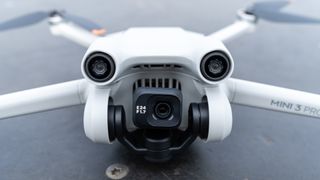
The Mavic Mini 3 Pro will be available in three configurations alongside a Fly More Bundle that provides additional batteries and other useful accessories. The cost of the drone has increased significantly since the Mavic Mini 2, so price-wise the Mini 3 Pro isn’t as beginner-friendly as its predecessor.
The first option is for the Mini 3 Pro without a controller which costs $669 / £639 and is aimed at users who already own a compatible controller. The second kit comes with a DJI RC-N1 controller and costs $759 / £709. This is the same controller that comes with the Mavic 3, Mavic Air 2S, Mavic Air 2 and the Mavic Mini 2. The third kit comes with the new DJI RC Smart Controller and costs $909 / £859.
All three kits include one Intelligent Flight Battery, two sets of propellers, a screwdriver, a gimbal guard and a Type-C to Type-C PD cable. The standard kit 9 (DJI RC-N1) also comes with cables to connect the controller to your smartphone while the other two options don’t include these cables.
A Fly More Bundle is also available separately and includes two Intelligent Flight Batteries, a three battery Charging Hub, two sets of propellers and a Shoulder Bag for $189 / £159. A Fly More Kit Plus with the higher capacity Intelligent Flight Battery Plus instead of standard batteries is also available in the United States for $249 and in Australia for AU $359.

Should you buy the DJI Mini 3 Pro?
The arrival of the DJI Mini 3 Pro alleviates the shortcomings of previous models to provide a much more rounded drone suitable for both enthusiasts and professional use. The collision avoidance, automated flight patterns and Follow Me functionality are a gamechanger for the series, so if you require an incredibly small and lightweight drone to carry alongside other photographic/video gear, the Mini 3 Pro is a fantastic option.
For professional drone pilots, the attraction of the drone will undoubtedly be the ability to shoot Raw stills and 4K video up to 60fps in the D-Cinelike profile. And the sub 250g category of the drone means that pilots with specific qualifications can fly in more places and even closer to people, which ultimately provides more creative possibilities.
If this drone isn't for you
For some photographers and videographers, the Mini 3 Pro simply won’t provide the features, functionality, and image quality and control provided by other DJI drones. So, if you’re looking for the ultimate portable drone in the DJI Mavic lineup, the Mavic 3 offers a more advanced camera with a Four Thirds sensor and an adjustable aperture for greater exposure control. Image quality is excellent, and a second camera provides additional functionality.
If the cost of the Mavic 3 is too high, another alternative to consider is the Mavic Air 2S. In terms of size and weight, this sits between the Mavic Mini 3 Pro and Mavic 3 and offers a 1-inch sensor with a fixed aperture. Image quality is once again excellent, so depending on budget, size requirements and image quality the Mavic 3, Mavic Air 2S and Mavic Mini 3 Pro provide amazing options for drone pilots with specific requirements.
If you're looking for a bargain and none of those take your fancy, you can also check out our roundup of all the best drone deals out there. We regularly update this page with the latest savings and discounts.
Join our Space Forums to keep talking space on the latest missions, night sky and more! And if you have a news tip, correction or comment, let us know at: community@space.com.
James is an award-winning freelance landscape and portrait photographer, as well as a highly experienced photography journalist working with some of the best photography magazines and websites with a worldwide audience. He’s also the author of The Digital Darkroom: The Definitive Guide to Photo Editing. www.jamesaphoto.co.uk
